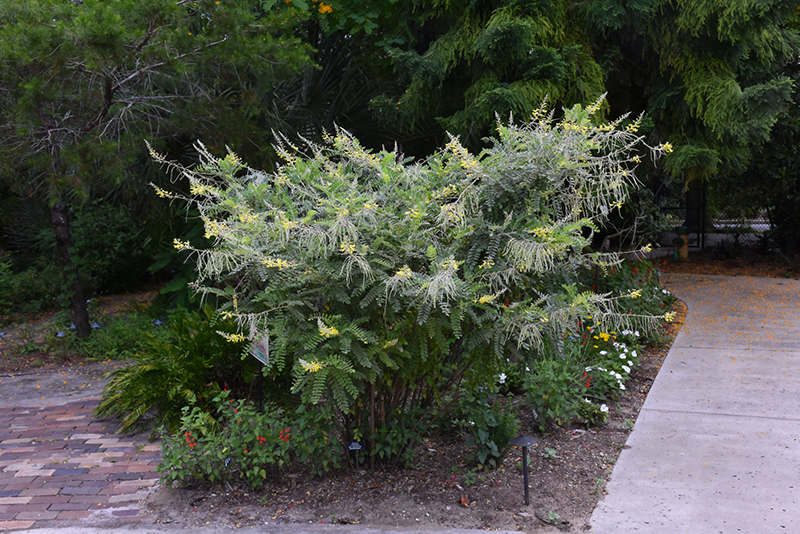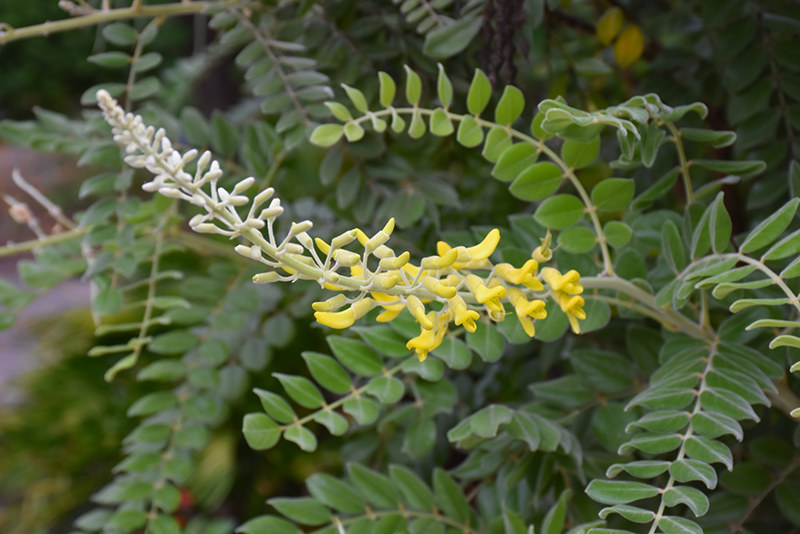Height: 9 feet
Spread: 10 feet
Sunlight:
![]()
Hardiness Zone: 8b
Other Names: Yellow Sophora, Necklace Pod Sophora, Silver Bush
Description:
An evergreen, very drought tolerant medium-sized shrub with thick, oval leaves covered with woolly hairs; yellow, pea like flowers appear in large clusters from spring to fall, followed by tan pods; great for water-wise landscapes
Ornamental Features
Yellow Necklacepod features showy clusters of fragrant yellow pea-like flowers at the ends of the branches from early spring to mid fall, which emerge from distinctive creamy white flower buds. It has attractive green foliage with hints of silver. The fuzzy oval pinnately compound leaves are highly ornamental and remain green throughout the winter. The fruits are showy chartreuse pods which fade to tan over time, which are carried in abundance from mid summer to early winter. The rough khaki (brownish-green) bark adds an interesting dimension to the landscape.
Landscape Attributes
Yellow Necklacepod is a dense multi-stemmed evergreen shrub with an upright spreading habit of growth. Its relatively fine texture sets it apart from other landscape plants with less refined foliage.
This shrub will require occasional maintenance and upkeep, and is best pruned in late winter once the threat of extreme cold has passed. It is a good choice for attracting bees and butterflies to your yard, but is not particularly attractive to deer who tend to leave it alone in favor of tastier treats. It has no significant negative characteristics.
Yellow Necklacepod is recommended for the following landscape applications;
- Accent
- Mass Planting
- Hedges/Screening
- General Garden Use
- Naturalizing And Woodland Gardens
- Container Planting
Planting & Growing
Yellow Necklacepod will grow to be about 9 feet tall at maturity, with a spread of 10 feet. It has a low canopy with a typical clearance of 3 feet from the ground, and is suitable for planting under power lines. It grows at a slow rate, and under ideal conditions can be expected to live for 50 years or more.
This shrub should only be grown in full sunlight. It prefers dry to average moisture levels with very well-drained soil, and will often die in standing water. It is considered to be drought-tolerant, and thus makes an ideal choice for xeriscaping or the moisture-conserving landscape. This plant should not require much in the way of fertilizing once established, although it may appreciate a shot of general-purpose fertilizer from time to time early in the growing season. It is not particular as to soil type or pH. It is highly tolerant of urban pollution and will even thrive in inner city environments. This species is not originally from North America, and parts of it are known to be toxic to humans and animals, so care should be exercised in planting it around children and pets..
Yellow Necklacepod makes a fine choice for the outdoor landscape, but it is also well-suited for use in outdoor pots and containers. Its large size and upright habit of growth lend it for use as a solitary accent, or in a composition surrounded by smaller plants around the base and those that spill over the edges. It is even sizeable enough that it can be grown alone in a suitable container. Note that when grown in a container, it may not perform exactly as indicated on the tag - this is to be expected. Also note that when growing plants in outdoor containers and baskets, they may require more frequent waterings than they would in the yard or garden.


